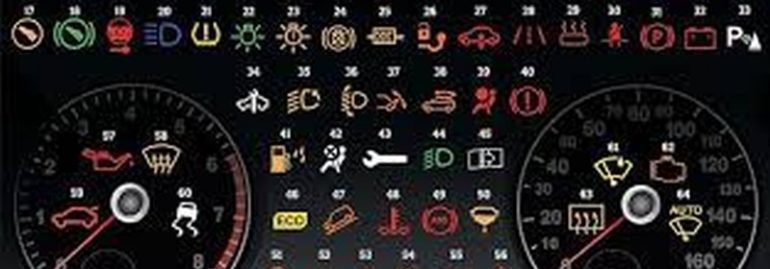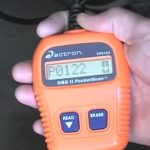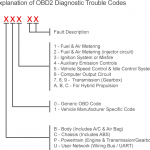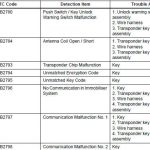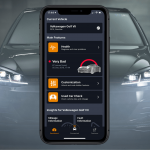Troubleshooting a car requires the reading of diagnostic trouble codes. There are two types of codes: generic and enhanced. Generic codes are required for emission diagnosis and enhanced codes are related to the vehicle’s additional features. Generic codes can be up to six digits long, while enhanced codes may be as many as eleven digits long. Using diagnostic trouble codes requires special equipment to read them. Below are some ways to read trouble codes on cars.
OBD codes
If your car’s Check Engine Light comes on, it’s important to understand the meaning of the codes. This is because OBD codes on cars are comprised of letters and numbers. The first digit indicates what the code means and the second indicates which system it’s related to. The last two digits indicate the fault designation. Once you understand the meaning of the code, you can take the next step to resolve the problem.
OBD codes are categorized into four different categories. General codes, or generic codes, cover common car problems. Manufacturer-specific codes, on the other hand, may be specific to a particular manufacturer. In general, a vehicle will have a code for the engine, transmission, or auxiliary emissions control. Other areas of the car that are affected by OBD codes include the chassis, axles, and brake fluid. These categories are outlined in the driver’s manual for the specific car model.
OBD codes on cars are important for a variety of reasons. They are often related to engine problems. If you have trouble with a specific component, OBD codes on cars can indicate the exact problem. A malfunctioning sensor could cause a vehicle to run more slowly or even stop altogether. A malfunction indicator light will light up to let you know if the car needs repair or replacement. This information is vital for a mechanic to diagnose a vehicle.
In most vehicles, the onboard diagnostic system (OBD) records trouble codes that correspond to a specific vehicle problem. Each code indicates a specific fault. The Society of Automotive Engineers maintains a manual that lists the causes and solutions for each fault code. If you notice any issues on your car, the codes will help you make a proper diagnosis. So, don’t be afraid to seek help from a mechanic if your car is giving you problems.
OBD codes on cars are important for determining whether a vehicle is running too hot, too cold, or needs repair. The computer that runs the engine monitors reads the various sensors in real time. The computer then interprets the data and logs it as a DTC. The DTC can be read through the OBD port, and this will help you fix any problems in your car. But if you’re not sure how to use the code reader on your car, you can buy an OBD scan tool.
Mercedes-Benz QR codes
The emergency services will have no problem accessing injured occupants of a car if it’s equipped with QR codes on its windshield. Currently, first responders have to sift through printed rescue sheets to determine which car is responsible for an accident. However, Mercedes-Benz has taken the extra step and voluntarily waived patent rights for its QR code technology. This way, other automakers can use the system and benefit from its many advantages.
Another great benefit of QR codes is that they’re useful for transferring clients and extra details from advertising. The new technology can be retrofitted to older Mercedes models, so first responders don’t have to spend time guessing what car is involved in an accident. In the case of a car crash, time is of the essence. The new technology will enable first responders to quickly and safely access rescue maps. While the technology is not yet fully developed, the company is confident that it can make a difference in the lives of victims and the public.
Another advantage of the Mercedes-Benz QR codes on cars is their ability to help rescuers quickly access important car components in an emergency. Rescuers can view diagrams of important components, including high-voltage systems in hybrid and electric vehicles. Additionally, these codes can be rotated or scaled to better view different parts of the car. As a result, they’ll know exactly where to insert their cutters, which will save lives in a crisis situation.
The next phase is to fit these QR codes on newer models. Initially, the codes will be placed on the fuel door and the opposite side B-pillar. But that’s not the end of the story for the company. Instead of patenting their QR codes, the company is hoping that other automakers will follow suit and implement them in their vehicles. This would save both time and money. It would also be logistically easier for other automakers to follow suit.
As an added benefit, the company also hopes to save lives. By placing these codes on cars, the German Automobile Association recommends that drivers print them as a “rescue sheet.” This information is necessary for first responders to neutralize the dangers. This initiative could lead to more innovative applications of QR codes in the future. The future of car rescue may be bright! And the Mercedes-Benz QR codes on cars are just the beginning.
OBD scanners
An OBD scanner can identify various problems with your car and help you decide if it’s time for a professional repair or if you can do it yourself. The most critical codes relate to the engine and are the most costly to fix. By regularly diagnosing your car, you can save yourself a lot of money on repairs and maintenance. To learn more about OBD scanners for cars, you can visit websites that offer OBD code interpretation.
An OBD scanner reads data stored in the car’s ECU. The device then analyzes this data to identify the specific problem. It is essential to understand how the OBD system works before using an OBD scanner, since it helps auto mechanics detect and repair car problems. To use an OBD scanner properly, you must understand how the car’s engine works and what the various error codes mean. For example, if you have a faulty starter or a blown tire, your car may have a battery problem.
Unlike other OBD scanners, this device has many additional features. Besides reading fault codes, it can perform basic maintenance and repairs. The scan tool will also help you identify scam cars and other car issues. These tools are indispensable if you’re going to purchase a used car. A professional scanner will also allow you to read the car’s manufacturer code, which can identify any problems with the engine. A professional scanner will cost you several hundred dollars, so a home user should only buy one for your car.
In order to use an OBD scanner for codes on cars, you should first turn your vehicle’s ignition on. This will send power to the scanner so that it can interface with the car’s on-board computer. However, if the scanner does not light up, check your connection. The problem may be in the auxiliary power outlet. The OBD system gets its power from the same circuit as the cigarette lighter.
Symptoms of trouble codes
EVAP codes indicate that your vehicle’s evaporative emission control system is faulty. These codes can also cause a check engine light to illuminate and a fuel odor. In addition, some vehicles have problems with their speed control or idling systems. A faulty computer system or speed sensor can also set an EVAP trouble code. Transmission codes are also a common cause of these codes. Troubleshooting these problems requires specialized diagnostic tools and knowledge.
There are four main categories of codes, with each code corresponding to a different problem. Most trouble codes are related to engine functions and the drivetrain. Some trouble codes are common across all cars and are shared by many different systems. Some trouble codes are generic, while others are manufacturer-specific. Fortunately, a good diagnostic tool can help you figure out which trouble code your car is reporting. When it comes to finding the most common problems, knowing which ones are related to your vehicle can save you time and money.
If you suspect an engine problem, don’t ignore the Check Engine Light. If you see this light, it means the EGR system isn’t functioning properly. This part of the car controls the temperature of combustion, as well as the amount of nitrogen oxide it produces. Some drivers may notice poor fuel economy or rough idling. A clogged catalytic converter, electrical problems within the EGR circuit, and problems with the vehicle’s engine computer may be the culprit.
P0171 and P0174 are two common engine error codes that indicate an engine misfire. A misfire in fuel mixture causes a Check Engine Light to illuminate and a hesitant engine. A dirty mass air flow sensor or faulty fuel injectors can also be responsible for a poor performance. If these codes appear, it is best to contact a qualified mechanic for a proper diagnosis. Even a simple misfire can lead to expensive repairs.
Another common car problem involves an oxygen sensor. An oxygen sensor monitors the amount of oxygen in the exhaust, allowing the engine computer to adjust the fuel mixture. When the sensor malfunctions, the engine can experience irregular gas mileage and stalling.
A malfunctioning oxygen sensor can also result in a high number of other problems. This trouble code may also appear when the oxygen level inside the engine is too low or too rich. If the sensors are not working, the problem is with the O2 sensor, and you need to contact your mechanic for a proper diagnosis.


